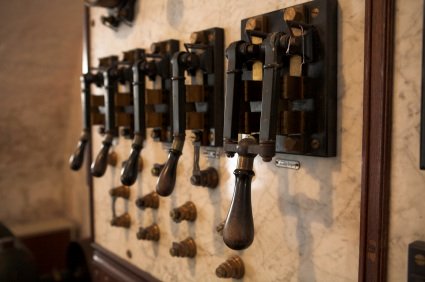on How to Build an Empire
 |
Common Electrical Switches Used in Model Railroad Wiring

Lots of different types of electrical switches can be used in wiring your model railroad. It can often be quite confusing trying to decide what kind of switch to use when. For example, what is the difference among the SPST, DPST, SPDT or DPDT varieties? What do all those letters mean?
Many modelers like to use the Atlas switches for their control panels to try to simplify the process, but even these are confusing sometimes. How do you know when to use the Atlas Selector, Connector, Twin and Relay Switches? Hopefully, this page will help clear things up.
Single Pole (SP) vs. Double Pole (DP)
The difference between single pole and double pole electrical switches is the number of items that the switch can control.
If you use a single pole switch, it will control one accessory. A double pole switch can control 2 accessories.
Single Throw (ST) vs. Double Throw (DT)
-The single throw electrical switch is an "on-off" type switch. One flip of the switch turns the light on, Flip the switch the other way and it turns off.
-A double throw switch is an "either-or" type switch. You have either one light on or another but not both. Or you have either one section of track powered on or another but not both at the same time. In other words, if you flip the switch one way, Light A comes on and Light B goes off. Flip it the other way, Light B comes on and A goes off.
Putting Them Together
SPST - Turns one light (or track) on or off.
DPST - Turns two separate things on or off using one switch.
SPDT - One way turns A on and B off. Flip the switch to turn B on and A off.
DPDT - One way turns 2 things on and 2 other things off. The other way reverses this. This can be used to control track polarity of an isolated section of track. One way turns Rail A positive and Rail B negative. The other way turns B positive and A negative.
Atlas Electrical Switches
-Each Atlas Connector switch is a collection of 3 simple SPST switches.
-Each Atlas Twin switch has 2 DPDT switches. These are used primarily for wiring reversing loops and wye tracks. For example, you can hook the main line tracks to one switch and the reverse loop section of track to the other switch. Each switch changes the polarity of the track one way or the other. When the train approaches the reverse loop and the turnout is pointed toward the right, the DPDT switch for the reverse loop polarity is set so that the polarity is lined up for that route. Then, as the train comes around the loop and approaches the other end of the reverse loop, the main line polarity has to be reversed by the second DPDT switch to accept the train coming back in a reverse direction. This is used mostly for block wiring, not DCC.
-An Atlas Selector switch basically can control the power to blocked sections of tracks coming from one source (transformer A) or another source (Transformer B). This again is mostly for block wiring, not DCC.
-To control lights in buildings, I just use the Atlas Connector switches (SPST) with each switch controlling a separate light. You can hook up more than one lamp to one switch (better to do it in-parallel than in-series) if you wish. This would be easy to do with a terminal strip. This might be a good idea if you have a lot of street lamps you want to control with one switch.
-An Atlas Snap Relay Switch can be used to to activate a secondary event once the switch to the primary event is thrown. For example, if you throw a switch to turn on a specific isolated section of track, wires from that circuit to the relay switch can cause lights to come on or an animation to be activated at the same time.
Other Types of Electrical Switches
Momentary Switches can be push-button or toggle-type switches that are spring-loaded so that when you push the button, power goes to the device only as long as the button is being pushed. As soon as the button is released, power goes off again. The Atlas version of this is the Switch Control Box (momentary slide switches), but there are many others as well.
These are used mostly for turnout switches since, if the power stays on to the switch machine too long, it will burn out. They are often used for uncoupling devices also.
Magnetic Reed Switches are long thin wire-like switches that are activated by the presence of a magnet. You can place one of these under the track rails between the ties and place a small magnet on the bottom of a railcar, so that when the railcar with the magnet travels over the switch, the device that the switch is connected to will be activated (e.g, a light in a building, a section of track or an animated device).
From "Electrical Switches" to "Model Railroad Wiring"
From "Electrical Switches" to "HomePage"
Contact Me | Blog | Photos | References | Supplies | GiftShop | Sitemap | Search | Comment | Privacy Statement | Disclosures



